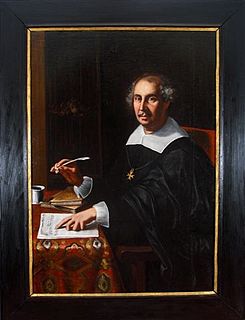Related Research Articles

Messina is a harbour city and the capital of the Italian Metropolitan City of Messina. It is the third largest city on the island of Sicily, and the 13th largest city in Italy, with a population of more than 231,000 inhabitants in the city proper and about 650,000 in the Metropolitan City. It is located near the northeast corner of Sicily, at the Strait of Messina and it is an important access terminal to Calabria region, Villa San Giovanni, Reggio Calabria on the mainland. According to Eurostat the FUA of the metropolitan area of Messina has, in 2014, 277,584 inhabitants.

A madrigal is a secular vocal music composition of the Renaissance and early Baroque (1600–1750) eras. The polyphonic madrigal is unaccompanied, and the number of voices varies from two to eight, but usually features three to six voices, whilst the metre of the madrigal varies between two or three tercets, followed by one or two couplets. Unlike the verse-repeating strophic forms sung to the same music, most madrigals are through-composed, featuring different music for each stanza of lyrics, whereby the composer expresses the emotions contained in each line and in single words of the poem being sung.
The year 1607 in music involved some significant events.
The year 1608 in music involved some significant events and new musical works.

Antonio Cifra was an Italian composer of the Roman School of the Renaissance and early Baroque eras. He was one of the significant transitional figures between the Renaissance and Baroque styles, and produced music in both idioms.

Tarquinio Merula was an Italian composer, organist, and violinist of the early Baroque era. Although mainly active in Cremona, stylistically he was a member of the Venetian school. He was one of the most progressive Italian composers of the early 17th century, especially in applying newly developed techniques to sacred music.

Alessandro Piccinini, was an Italian lutenist and composer.
Galeazzo Sabbatini (1597–1662) was an Italian composer and music theorist, born in Pesaro, Italy. Sabbatini studied with Vincenzo Pellegrini, a canon who worked at the local cathedral as musician. He was elected to succeed Pellegrini in 1626 and in 1641. From 1630 to 1639 he was chapel master to the Duke of Mirandola.
Peter Philips was an eminent English composer, organist, and Catholic priest exiled to Flanders. He was one of the greatest keyboard virtuosos of his time, and transcribed or arranged several Italian motets and madrigals by such composers as Lassus, Palestrina, and Giulio Caccini for his instruments. Some of his keyboard works are found in the Fitzwilliam Virginal Book. Philips also wrote many sacred choral works.
Giovanni Girolamo Kapsperger was an Austrian-Italian virtuoso performer and composer of the early Baroque period. A prolific and highly original composer, Kapsberger is chiefly remembered today for his lute and theorbo (chitarrone) music, which was seminal in the development of these as solo instruments.
The year 1610 in music involved some significant events.
The year 1619 in music involved some significant events.
The year 1614 in music involved some significant musical events.
The year 1605 in music involved some significant events.
The year 1609 in music involved some significant events.

Antonio Brunelli was an Italian composer and theorist of the early Baroque period.
Fray Bonaventura Rubino was an Italian composer.

StefanoBernardi, also known as "il Moretto", was an Italian priest, composer and music theorist. Born in Verona and maestro di cappella at the Verona Cathedral from 1611 to 1622, he later moved to Salzburg, where he was responsible for the music at the Salzburg Cathedral and composed a Te Deum for 12 choirs performed at the cathedral's consecration in 1628.
Domenico Obizzi was an Italian composer and singer. Worked in S Marco, Venice 1627 to 1630. At age 13 composed a motet for solo voice and continuo, Jubilate Deo, and in 1627 wrote Madrigali concertati a 2–5 voci con il basso continuo, libro primo and Madrigali et arie a voce sola, libro primo. According to R. Miller, "Obizzis music is well crafted and shows mastery not only in the fusion of affective madrigalian techniques with lilting tunefulness within the same strophic aria, but also in the way short epigrammatic madrigal texts are dramatized through clever repetitions of text and music.". Surviving works include his Madrigali et arie, Op.2.
References
- ↑ Carapezza, Paolo Emilio; Collisani, Giuseppe. "Bonaffino, Filippo". Oxford Music Online . Retrieved 1 March 2012.